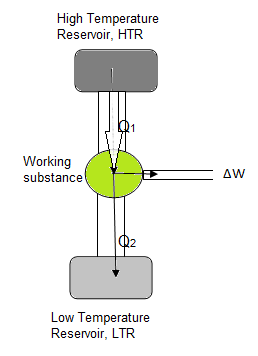Question 7: What is meant by heat engine? What is its main purpose? How is its efficiency defined?
ANSWER
Heat Engine
Heat engine is a device that converts heat energy into mechanical energy.
Construction/Parts of heat engine
A heat engine consists of the following parts.
1. Heat source or heat reservoir
Heat reservoir is a large source of heat energy at a higher temperature T1. It is also called High Temperature Reservoir (HTR). Its temperature remains practically constant during any in or out transfer of heat.
2. Heat sink or Cold Reservoir

It is a large reservoir at a lower temperature T2. It is also called Low Temperature Reservoir (LTR). Its temperature also practically remains constant during any in/out flow of heat.
3. Working Substance
The working substance, usually a gas, undergoes a cyclic process (ΔU = 0). During this process it absorbs some heat Q1 from HTR, uses it to do some work on the surrounding, and heat Q2 is rejected to the LTR.
Working Principle
The working substance extracts (absorbs) heat Q1from the HTR, do some work ΔW on the surrounding by utilizing part of it and rejects heat Q2 to the LTR. The process is carried out cyclically, i-e, ΔU = 0
Purpose of heat engine
Main purpose of heat engine is to utilize heat energy and convert it into useful work.
Efficiency of Heat engine
The efficiency η of a heat engine is defined as the ratio of its output to the input.
Where output is the work done (ΔW) and input is the heat absorbed, Q1.
Therefore,

As Q2/Q1always has some positive value, therefore, η is always less than 1. Therefore, in terms of % efficiency, the η is always less than 100%.
This shows it is impossible to construct a 100% efficient heat engine.
Alternatively, we can say it is impossible to construct a heat engine which will produce no effect other than extracting heat from a reservoir and the performance of an equal amount of work. This is in fact the Second Law of Thermodynamics.

Pingback:index-cq10-p11